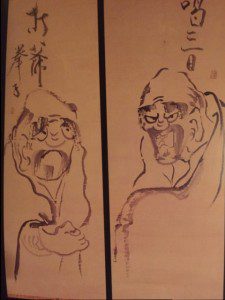 To the left you see Sengai’s wonderful rendition of the old masters Linji and Mazu. Are they embalmed or ruggedly themselves?
To the left you see Sengai’s wonderful rendition of the old masters Linji and Mazu. Are they embalmed or ruggedly themselves?
And what’s it matter, anyway?
James Myoun Ford and his Monkey Mind has this recent blog: ON ASPECTS OF THE REFORMATION OF SOTO ZEN BUDDHISM IN NORTH AMERICA.
In this post, James gives a brief history of the Soto Zen Buddhist Association and one of the central issues that the organization is dealing with now – standards for the training of priests before dharma transmission and the sticky issue of how to assess whether those standards have been met.
I shared James’ post on Facebook and got some “comments,” one by an old friend who said he smelled the “embalming fluid of orthodoxy” in the piece. Love the phrase!
Now the smell could just be James (note to reader: that’s said with great love). Or there might be an issue here that deserves some attention – to be free of forms or free within them?
James writes in an email, “As an observer of the Zen scene in the west for [the] past four decades, I am concerned about public perceptions of our project. It is largely informed by a romantic view ginned up from our beginnings by Alan Watts and others who were creating an anarchic spirituality, deeply individualistic, and anti-authoritarian, flavored with bits and pieces of koan literature highlighting spontaneity and erratic behaviors, and calling it Zen.”
I’m reminded, for example, of Linji’s famous “true person of no rank” and how that is often interpreted as supporting being free from organization and orthodoxy … and ethics and accountability. Dogen addresses this in SPEAKING OF MIND, SPEAKING OF ESSENCE: “The total expression by Linji is ‘a person with no rank,’ but he has not expressed ‘a person with rank.’”
The person of rank has limited freedom, caught in role, caught in the idea of self and Zen. How can you be free while tethered by rank?
On the other hand, the practice of a person with no rank has limited portability. How do you practice in the ordinary world of up and down, in and out, near or far, employment or unemployment? And if your personal style leans way into the “no rank” rank, then unemployment might be all too familiar to you.
In my view, we large-brained primates are social animals. Organization and orthodoxy are essential aspects of our success. At the same time, we are free and wild and those too are essential aspects of our success. For these two foci to engage in intimate conversation is a way of living a whole life and for an organization to be free of itself.
In the Japanese forms of Zen, I find an embodied expression of these foci. For the monastic, much of the day and night is ruled by the schedule and how to move within it, including meticulous detail about how to wear the robes, stand, sit, walk, use the toilet, sleep … you name it. Then the bell rings for dokusan and all hells breaks out. The practice then is to run with wholehearted, wild abandon to the dokusan line.
Those moments of breaking the forms are so important to maintaining the forms. They’re like the inhalation and exhalation or the back and front foot in walking.
How the intimate conversation between the foci of true person of no rank and true person of rank plays out now and here in our global culture is not yet clear.
What is clear is that it’s now up to us.











